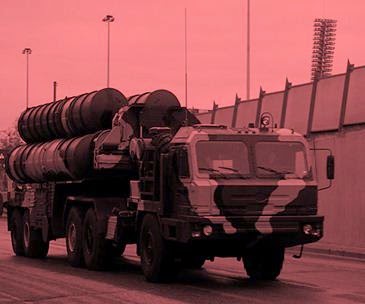
Sri Lanka’s Election: Implications for China and the U.S.
January 28, 2015
Arming Ukraine: Lessons for Beijing
February 27, 2015By Ian Easton |
An excellent Defense News report came out late last year with word that Russia might soon sell its advanced S-400 surface to air missile (SAM) system to China. This has understandably caused something of a panic in Taiwan security circles. Yet the threat may not be as dire as forecast. And, if nothing else, the sale raises a number of interesting questions about the logic of Moscow’s thinking.
First, is it in Russia’s strategic interest to have its most dangerous potential long-term adversary equipped with a system that could defend Beijing and reduce Russia’s already waning nuclear advantage? Second, will Russia install protective “black boxes†on the export variant of its S-400 SAM so China can’t steal and reverse engineer the technology? Will Russia otherwise reduce the export variant’s effectiveness? Or will Russia install an electronic back door into the export variant to allow for a remote access “kill switch†in time of need? Finally, what might this deal tell us about Chinese military weakness in terms of indigenous SAM technology?
As for the threat to Taiwan (if indeed S-400s do become operational across the Strait in the coming few years) it must be noted that Chinese air defenses are not invulnerable today, nor will they be in the future. There are a number of risks a Chinese S-400 unit operating near Taiwan, which is officially known as the Republic of China (ROC), would face. In peacetime, S-400 air surveillance radar, if turned on, would be subject to immediate interception by Taiwanese signals intelligence (SIGINT) units on Tung-yin Island, Matsu Island, and the Penghu Islands. It would also be vulnerable to American and Japanese SIGINT units on Okinawa and the surrounding islands, not to mention allied intelligence gathering submarines parked off the Chinese coast, as well as both manned and unmanned aircraft patrolling the East China Sea. Once radar emissions have been captured, they can be studied for the purpose of countermeasure development.
The effective range of the S-400 system is reportedly quite impressive (if one is to believe Russian claims),  but even with such an intrusive look into Taiwan’s territorial air space, China would not have SAM coverage over Taiwan’s air bases at most operational altitudes. And when in the threat envelope, Republic of China Air Force (ROCAF) pilots could fly low under the system’s radar, which is limited by the curvature of the earth and can’t penetrate Taiwan’s extremely mountainous geography. In addition, it is often forgotten that Taiwan has had excellent SAM coverage over much of China’s Southeastern seaboard for well over a decade. China is trying to play catch-up with Taiwan and still not there yet.
During a full-scale conflict, Chinese S-400 SAMs across the Taiwan Strait would be vulnerable to attack by Taiwanese electronic jamming and cyber warfare units, anti-radiation drones, cruise missiles, special operations forces, and “wild weasel” type aircraft. Â Assuming U.S. intervention, F-22 stealth fighters would also be able to hold Chinese SAMs at risk irrespective of how advanced they may be, and the S-400 would be no exception.
This possible SAM sale therefore highlights the growing importance of Taiwan’s indigenous self-defense programs, including its stealthy unmanned aerial vehicle program, its HF-2E cruise missile program, and its Wan Chien missile program. A Chinese S-400 battalion would be useless against all of these capabilities, and thus highly vulnerable to paralyzing strikes against its command posts and radar nets. Taiwan can still neutralize single nodes of failure in China even with a growing fighter gap working against it.
Nonetheless, it would be imprudent to be overly sanguine. Chinese S-400s would indeed put pressure on ROCAF fighters conducting routine patrols in Taiwan’s air defense identification zone (ADIZ). They would also offer China an improved defense against Taiwanese F-16s tasked with counterstrike missions during a conflict. To defend against future Chinese SAMs it is important for Taiwan to acquire new fifth generation fighters like the F-35 or a similar indigenous aircraft.  With or without Chinese S-400s, the Taiwan Strait military environment is fast becoming one of the most challenging in the world. ROCAF’s pilots have most of the training they need to deny their communist Chinese adversaries air superiority. However, Taiwan must acquire more advanced fighters, missile defense systems, and cruise missiles to keep its defensive edge in this emerging environment.
There is much Washington could do to help improve Taiwan’s air defenses. For starters, the U.S. should grant Taiwan full participation in the air force Red Flag exercises in Nevada and Alaska. American, Japanese and Taiwanese pilots need to war-game alongside each other and learn from each other.  Each partner air force brings something to the table the others don’t have, and ultimately they could all be fighting alongside each other one day in the event that known contingencies were to occur. So it would be best for them to work out the kinks early.
Yet despite the urgent need for greater interoperability between democratic partner nations in East Asia, it appears the U.S. is going to continue bowing to Chinese pressure and keep Taiwan out of Red Flag. For this reason and many others, the Pacific Command is going to find itself sub-optimally prepared to face the emerging strategic environment in the Western Pacific. American policymakers and strategists could do better in supporting Taiwan. And Taiwan could do more to highlight its concerns regarding China’s military build-up. This is no time to panic.




